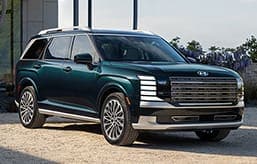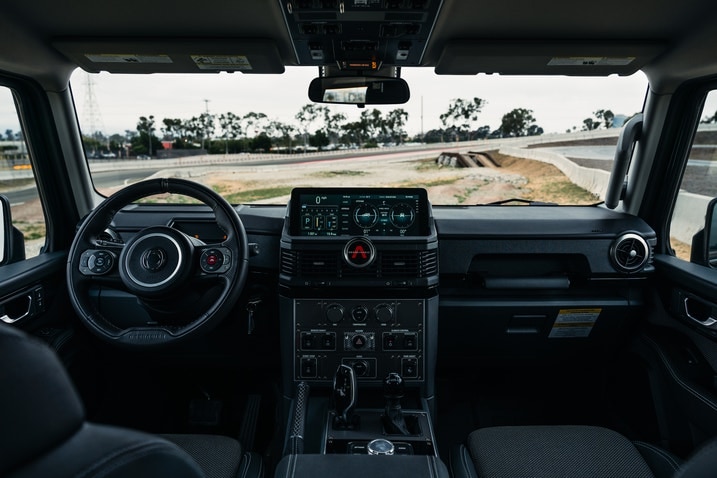- The Ineos Grenadier clearly pays homage to the old Land Rover Defender.
- But this is a brand-new SUV with a BMW-sourced powertrain.
- The interior feels like the cockpit of a jet, and it's awesome.
- The Grenadier is expensive and offers mixed performance on- and off-road.
2024 Ineos Grenadier Tested: A New SUV That Goes Heavy on Old-School Feel
We put Ineos' first SUV to the test, both on- and off-road
The Ineos Grenadier is delightfully old-school, from its old Land Rover Defender-inspired styling to its ladder-frame underpinnings and lack of advanced technology. It's meant to be a vehicle of simplicity, an intentional old-school formula at a time when cars are starting to feel more and more like computers.
Part of the Grenadier's origin story is that the new Land Rover Defender — formerly a rugged old thing — moved to a unibody platform and gained a significant amount of mechanical and technological complexity. Ineos noted that, in contrast to the new Defender, which has over 100 electronic control modules (read: small computers that help the vehicle operate), the Grenadier has just 35.
Hitting the test track
The Grenadier uses a familiar powertrain: BMW's B58 engine, a turbocharged 3.0-liter straight-six mated to an eight-speed automatic transmission. In this application, the inline-six is paired to a full-time four-wheel-drive system and has been retuned to make more low-end torque, which aids with off-road performance. The Grenadier offers 281 horsepower and 331 lb-ft of torque, while a BMW X5 with this same engine makes 375 hp — a pretty significant difference.
How'd the Grenadier do in our testing?
- 0 to 60 mph: 8.8 seconds
- Quarter mile: 16.6 seconds at 81.9 mph
Those are some disappointing figures given the pedigree of the engine. But it's also worth remembering that the Grenadier tips the scales at 6,133 pounds.
For some perspective, similarly sized off-roaders are much quicker to 60 mph, including the Lexus GX 550 Overtrail+ (6.7 seconds) and the Ford Bronco First Edition (7.3 seconds).
Our Grenadier had the Rugged pack, which adds front and rear locking differentials and some aggressive BFGoodrich KO2 all-terrain tires. Those tires are fantastic off-road, but they provide limited grip on pavement. This contributed to even more poor performance when it came to braking distance and grip.
- Braking, 60 to 0 mph: 152 feet
- Skidpad lateral grip: 0.61 g
The braking distance is troubling because, while we got 152 feet on our first run, things only got worse from there, pushing to 162 feet, then more than 170 feet. On the street, the brake pedal feels squishy and truck-like but it's easy to modulate to stop smoothly. However, the lack of panic-stopping power is worrisome.
On the skidpad, the Grenadier's stability and traction control systems were very intrusive, and those off-road tires and tons of body roll contributed to its low grip number. Looking at the GX and Bronco again — both of which were tested on aggressive all-terrain tires — you'll see that the Grenadier is once again outshined.
- Lexus GX: 126 feet, 0.75 g
- Ford Bronco: 142 feet, 0.71 g
On our handling track, problems with the Ineos' steering came to the forefront. The Grenadier has a recirculating-ball setup with hydraulic power, necessitated by this SUV's live front axle. The Jeep Wrangler also uses this steering type, and both vehicles share similarly vague on-center feel. But while the Grenadier tracks straighter than the Jeep, it has a weird quirk where the steering wheel doesn't unwind; if you let go of the wheel coming out of a turn, it won't work its way back to center as you'd expect. This is something that continued to catch us off guard.
The stability control problems also continued, as the system would cut power at any sign of slippage. If we tried to turn the ESC off, it would come back on a short time later. Of course, the Grenadier's struggles on our test track were predictable; this SUV wasn't built to excel in on-road dynamics. (Clearly.) So, that meant we had to hit the dirt.
Off-road testing
Our track testing tends to be more scientific, while off-road testing tends to be based on how a vehicle feels from behind the wheel, and if it can complete a four-pack of tests: the ziggurat, a hill climb, a horseshoe (made of concrete pipes), and a high-speed run through a sandy wash.
The Grenadier doesn't offer disconnecting front or rear sway bars, but it made it to the third step of the ziggurat climb, which is exactly where the Lexus GX, Mercedes-Benz G 550 Professional, and Toyota Land Cruiser all landed. What was more impressive was that, once it was up there, we could see three heavy-duty skid plates (front, fuel tank and rear) and that all of the control arms were shielded by metal. The Grenadier also has offset front and rear differentials, and with them being closer to the wheels, you gain a bit more clearance and don't have to worry about lowpointing the center of the vehicle.
Though it lacks some of the sophisticated traction and terrain management settings of modern off-roaders, the Grenadier made it up the deeply rutted hill climb in low-range four-wheel drive with only the center and rear lockers activated. Getting the Ineos into low range is delightfully old-school; instead of pressing a button, you have to lock the shifter into low yourself. The super weird part is seeing the old ball shift locker next to the very modern BMW-sourced gear selector.
Torque delivery on the hill climb was very even. We held the transmission in second gear and crawled up the hill with about half throttle application. But on the next obstacle, the horseshoe, the throttle mapping proved more troublesome. It was hard to manage consistent power delivery. That said, the Grenadier had an easier time making it over the horseshoe than Mercedes' G 550 Professional. The Grenadier has 10.5 inches of ground clearance and great off-road geometry (36.2-degree approach, 28.2-degree breakover, 36.1-degree departure angles). Meanwhile, it took the G 550 Professional (9.5 inches of clearance, 30.9/23.5/29.9 degrees) more than double the time to complete the same test. And the Lexus GX and Toyota Land Cruiser didn't have enough clearance to even attempt the second half of the course.
Our final test was a run through a sandy wash at high speed. Or we should say, attempted high-speed, because keeping the Grenadier's momentum up proved to be difficult. The only selectable drive mode for the Grenadier is Off-Road, and though that loosened the reins of the traction control, getting the SUV to consistently put power down was tricky. Left to its own devices, the transmission was always a gear too high, and even shifting manually, the SUV would upshift into third gear when we wanted it to stay in second.
The steering problems also reappeared off-road. Going into corners, we would try to hang the rear out and stay on the throttle to maintain speed, but the steering wheel would occasionally not unwind. Our hands were constantly flying around to get the front wheels aligned to apply some opposite lock, so much so that we started to get winded after a few runs through the wash.
A niche vehicle at a high price
Here's the thing: The Grenadier is an undeniably cool SUV. The exterior styling is boxy and rugged, and inside, the front of the cabin looks and feels like you're flying a plane instead of driving an automobile. This is a vehicle that could have only come from a startup; established companies have too many forces dictating that their products look and feel a certain way. But Ineos? It's like the team sat around a table and said, "That looks fun. Let's do it!"
If your desire is an analog off-road experience in a machine that oozes British cool, the Ineos delivers in a way that nothing else can. That experience isn't cheap, though; our Grenadier has an as-tested price of $83,750, which is hard to swallow when you think about all of the things you aren't getting (surround-view camera, modern safety features, luxury trimmings).
For better or worse, there's nothing else out there that drives like a Grenadier.





 by
by  edited by
edited by